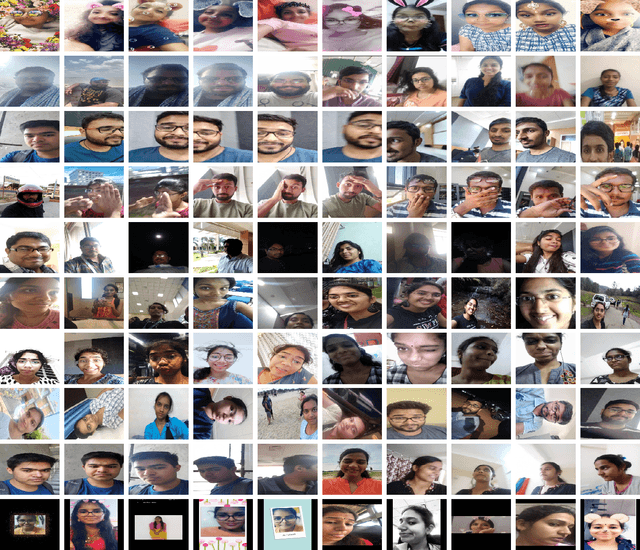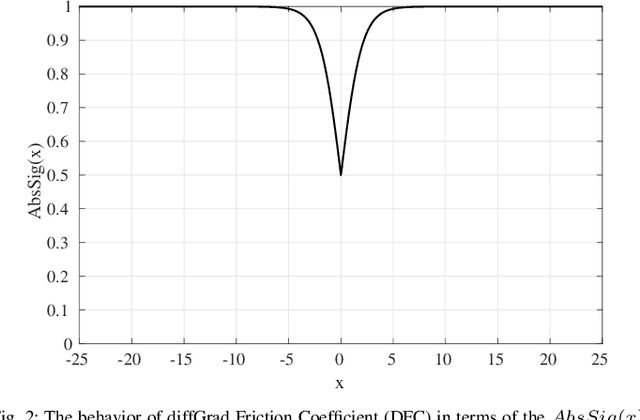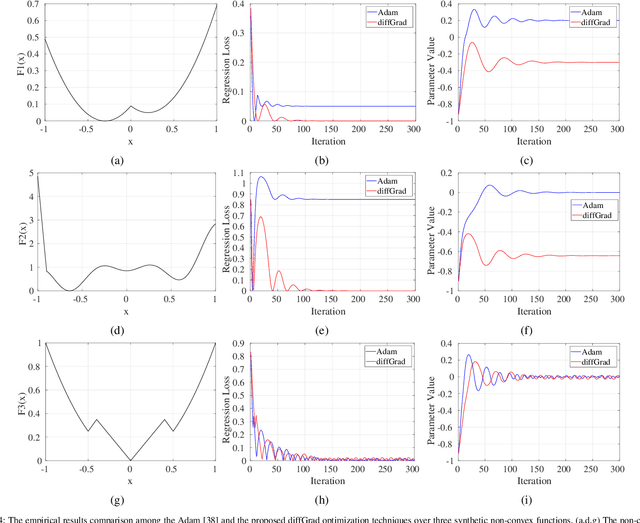Snehasis Mukherjee
Plantation Monitoring Using Drone Images: A Dataset and Performance Review
Feb 12, 2025Abstract:Automatic monitoring of tree plantations plays a crucial role in agriculture. Flawless monitoring of tree health helps farmers make informed decisions regarding their management by taking appropriate action. Use of drone images for automatic plantation monitoring can enhance the accuracy of the monitoring process, while still being affordable to small farmers in developing countries such as India. Small, low cost drones equipped with an RGB camera can capture high-resolution images of agricultural fields, allowing for detailed analysis of the well-being of the plantations. Existing methods of automated plantation monitoring are mostly based on satellite images, which are difficult to get for the farmers. We propose an automated system for plantation health monitoring using drone images, which are becoming easier to get for the farmers. We propose a dataset of images of trees with three categories: ``Good health", ``Stunted", and ``Dead". We annotate the dataset using CVAT annotation tool, for use in research purposes. We experiment with different well-known CNN models to observe their performance on the proposed dataset. The initial low accuracy levels show the complexity of the proposed dataset. Further, our study revealed that, depth-wise convolution operation embedded in a deep CNN model, can enhance the performance of the model on drone dataset. Further, we apply state-of-the-art object detection models to identify individual trees to better monitor them automatically.
UnSeGArmaNet: Unsupervised Image Segmentation using Graph Neural Networks with Convolutional ARMA Filters
Oct 08, 2024



Abstract:The data-hungry approach of supervised classification drives the interest of the researchers toward unsupervised approaches, especially for problems such as medical image segmentation, where labeled data are difficult to get. Motivated by the recent success of Vision transformers (ViT) in various computer vision tasks, we propose an unsupervised segmentation framework with a pre-trained ViT. Moreover, by harnessing the graph structure inherent within the image, the proposed method achieves a notable performance in segmentation, especially in medical images. We further introduce a modularity-based loss function coupled with an Auto-Regressive Moving Average (ARMA) filter to capture the inherent graph topology within the image. Finally, we observe that employing Scaled Exponential Linear Unit (SELU) and SILU (Swish) activation functions within the proposed Graph Neural Network (GNN) architecture enhances the performance of segmentation. The proposed method provides state-of-the-art performance (even comparable to supervised methods) on benchmark image segmentation datasets such as ECSSD, DUTS, and CUB, as well as challenging medical image segmentation datasets such as KVASIR, CVC-ClinicDB, ISIC-2018. The github repository of the code is available on \url{https://github.com/ksgr5566/UnSeGArmaNet}.
WSD: Wild Selfie Dataset for Face Recognition in Selfie Images
Feb 14, 2023



Abstract:With the rise of handy smart phones in the recent years, the trend of capturing selfie images is observed. Hence efficient approaches are required to be developed for recognising faces in selfie images. Due to the short distance between the camera and face in selfie images, and the different visual effects offered by the selfie apps, face recognition becomes more challenging with existing approaches. A dataset is needed to be developed to encourage the study to recognize faces in selfie images. In order to alleviate this problem and to facilitate the research on selfie face images, we develop a challenging Wild Selfie Dataset (WSD) where the images are captured from the selfie cameras of different smart phones, unlike existing datasets where most of the images are captured in controlled environment. The WSD dataset contains 45,424 images from 42 individuals (i.e., 24 female and 18 male subjects), which are divided into 40,862 training and 4,562 test images. The average number of images per subject is 1,082 with minimum and maximum number of images for any subject are 518 and 2,634, respectively. The proposed dataset consists of several challenges, including but not limited to augmented reality filtering, mirrored images, occlusion, illumination, scale, expressions, view-point, aspect ratio, blur, partial faces, rotation, and alignment. We compare the proposed dataset with existing benchmark datasets in terms of different characteristics. The complexity of WSD dataset is also observed experimentally, where the performance of the existing state-of-the-art face recognition methods is poor on WSD dataset, compared to the existing datasets. Hence, the proposed WSD dataset opens up new challenges in the area of face recognition and can be beneficial to the community to study the specific challenges related to selfie images and develop improved methods for face recognition in selfie images.
DFW-PP: Dynamic Feature Weighting based Popularity Prediction for Social Media Content
Oct 16, 2021



Abstract:The increasing popularity of social media platforms makes it important to study user engagement, which is a crucial aspect of any marketing strategy or business model. The over-saturation of content on social media platforms has persuaded us to identify the important factors that affect content popularity. This comes from the fact that only an iota of the humongous content available online receives the attention of the target audience. Comprehensive research has been done in the area of popularity prediction using several Machine Learning techniques. However, we observe that there is still significant scope for improvement in analyzing the social importance of media content. We propose the DFW-PP framework, to learn the importance of different features that vary over time. Further, the proposed method controls the skewness of the distribution of the features by applying a log-log normalization. The proposed method is experimented with a benchmark dataset, to show promising results. The code will be made publicly available at https://github.com/chaitnayabasava/DFW-PP.
Deep Model Compression based on the Training History
Jan 30, 2021



Abstract:Deep Convolutional Neural Networks (DCNNs) have shown promising results in several visual recognition problems which motivated the researchers to propose popular architectures such as LeNet, AlexNet, VGGNet, ResNet, and many more. These architectures come at a cost of high computational complexity and parameter storage. To get rid of storage and computational complexity, deep model compression methods have been evolved. We propose a novel History Based Filter Pruning (HBFP) method that utilizes network training history for filter pruning. Specifically, we prune the redundant filters by observing similar patterns in the L1-norms of filters (absolute sum of weights) over the training epochs. We iteratively prune the redundant filters of a CNN in three steps. First, we train the model and select the filter pairs with redundant filters in each pair. Next, we optimize the network to increase the similarity between the filters in a pair. It facilitates us to prune one filter from each pair based on its importance without much information loss. Finally, we retrain the network to regain the performance, which is dropped due to filter pruning. We test our approach on popular architectures such as LeNet-5 on MNIST dataset and VGG-16, ResNet-56, and ResNet-110 on CIFAR-10 dataset. The proposed pruning method outperforms the state-of-the-art in terms of FLOPs reduction (floating-point operations) by 97.98%, 83.42%, 78.43%, and 74.95% for LeNet-5, VGG-16, ResNet-56, and ResNet-110 models, respectively, while maintaining the less error rate.
MERANet: Facial Micro-Expression Recognition using 3D Residual Attention Network
Dec 07, 2020



Abstract:We propose a facial micro-expression recognition model using 3D residual attention network called MERANet. The proposed model takes advantage of spatial-temporal attention and channel attention together, to learn deeper fine-grained subtle features for classification of emotions. The proposed model also encompasses both spatial and temporal information simultaneously using the 3D kernels and residual connections. Moreover, the channel features and spatio-temporal features are re-calibrated using the channel and spatio-temporal attentions, respectively in each residual module. The experiments are conducted on benchmark facial micro-expression datasets. A superior performance is observed as compared to the state-of-the-art for facial micro-expression recognition.
AutoTune: Automatically Tuning Convolutional Neural Networks for Improved Transfer Learning
Apr 25, 2020



Abstract:Transfer learning enables solving a specific task having limited data by using the pre-trained deep networks trained on large-scale datasets. Typically, while transferring the learned knowledge from source task to the target task, the last few layers are fine-tuned (re-trained) over the target dataset. However, these layers are originally designed for the source task which might not be suitable for the target task. In this paper, we introduce a mechanism for automatically tuning the Convolutional Neural Networks (CNN) for improved transfer learning. The CNN layers are tuned with the knowledge from target data using Bayesian Optimization. Initially, we train the final layer of the base CNN model by replacing the number of neurons in the softmax layer with the number of classes involved in the target task. Next, the CNN is tuned automatically by observing the classification performance on the validation data (greedy criteria). To evaluate the performance of the proposed method, experiments are conducted on three benchmark datasets, e.g., CalTech-101, CalTech-256, and Stanford Dogs. The classification results obtained through the proposed AutoTune method outperforms the standard baseline transfer learning methods over the three datasets by achieving $95.92\%$, $86.54\%$, and $84.67\%$ accuracy over CalTech-101, CalTech-256, and Stanford Dogs, respectively. The experimental results obtained in this study depict that tuning of the pre-trained CNN layers with the knowledge from the target dataset confesses better transfer learning ability.
An Information-rich Sampling Technique over Spatio-Temporal CNN for Classification of Human Actions in Videos
Feb 07, 2020



Abstract:We propose a novel scheme for human action recognition in videos, using a 3-dimensional Convolutional Neural Network (3D CNN) based classifier. Traditionally in deep learning based human activity recognition approaches, either a few random frames or every $k^{th}$ frame of the video is considered for training the 3D CNN, where $k$ is a small positive integer, like 4, 5, or 6. This kind of sampling reduces the volume of the input data, which speeds-up training of the network and also avoids over-fitting to some extent, thus enhancing the performance of the 3D CNN model. In the proposed video sampling technique, consecutive $k$ frames of a video are aggregated into a single frame by computing a Gaussian-weighted summation of the $k$ frames. The resulting frame (aggregated frame) preserves the information in a better way than the conventional approaches and experimentally shown to perform better. In this paper, a 3D CNN architecture is proposed to extract the spatio-temporal features and follows Long Short-Term Memory (LSTM) to recognize human actions. The proposed 3D CNN architecture is capable of handling the videos where the camera is placed at a distance from the performer. Experiments are performed with KTH and WEIZMANN human actions datasets, whereby it is shown to produce comparable results with the state-of-the-art techniques.
AutoFCL: Automatically Tuning Fully Connected Layers for Transfer Learning
Feb 05, 2020



Abstract:Deep Convolutional Neural Networks (CNN) have evolved as popular machine learning models for image classification during the past few years, due to their ability to learn the problem-specific features directly from the input images. The success of deep learning models solicits architecture engineering rather than hand-engineering the features. However, designing state-of-the-art CNN for a given task remains a non-trivial and challenging task. While transferring the learned knowledge from one task to another, fine-tuning with the target-dependent fully connected layers produces better results over the target task. In this paper, the proposed AutoFCL model attempts to learn the structure of Fully Connected (FC) layers of a CNN automatically using Bayesian optimization. To evaluate the performance of the proposed AutoFCL, we utilize five popular CNN models such as VGG-16, ResNet, DenseNet, MobileNet, and NASNetMobile. The experiments are conducted on three benchmark datasets, namely CalTech-101, Oxford-102 Flowers, and UC Merced Land Use datasets. Fine-tuning the newly learned (target-dependent) FC layers leads to state-of-the-art performance, according to the experiments carried out in this research. The proposed AutoFCL method outperforms the existing methods over CalTech-101 and Oxford-102 Flowers datasets by achieving the accuracy of 94.38% and 98.89%, respectively. However, our method achieves comparable performance on the UC Merced Land Use dataset with 96.83% accuracy.
diffGrad: An Optimization Method for Convolutional Neural Networks
Sep 12, 2019



Abstract:Stochastic Gradient Decent (SGD) is one of the core techniques behind the success of deep neural networks. The gradient provides information on the direction in which function has the steepest rate of change. The main problem with basic SGD is to change by equal sized steps for all parameters, irrespective of gradient behavior. Hence, an efficient way of deep network optimization is to make adaptive step sizes for each parameter. Recently, several attempts have been made to improve gradient descent methods such as AdaGrad, AdaDelta, RMSProp and Adam. These methods rely on the square roots of exponential moving averages of squared past gradients. Thus, these methods do not take the advantage of local change in gradients. In this paper, a novel optimizer is proposed based on the difference between the present and the immediate past gradient (i.e., diffGrad). In the proposed diffGrad optimization technique, the step size is adjusted for each parameter in such a way that it should have a larger step size for faster gradient changing parameters and lower step size for lower gradient changing parameters. The convergence analysis is done using the regret bound approach of online learning framework. Rigorous analysis is made in this paper over three synthetic complex non-convex functions. The image categorization experiments are also conducted over the CIFAR10 and CIFAR100 datasets to observe the performance of diffGrad with respect to the state-of-the-art optimizers such as SGDM, AdaGrad, AdaDelta, RMSProp, AMSGrad, and Adam. The residual unit (ResNet) based Convolutional Neural Networks (CNN) architecture is used in the experiments. The experiments show that diffGrad outperforms the other optimizers. Also, we showed that diffGrad performs uniformly well on network using different activation functions. The source code is made publicly available at https://github.com/shivram1987/diffGrad.
 Add to Chrome
Add to Chrome Add to Firefox
Add to Firefox Add to Edge
Add to Edge